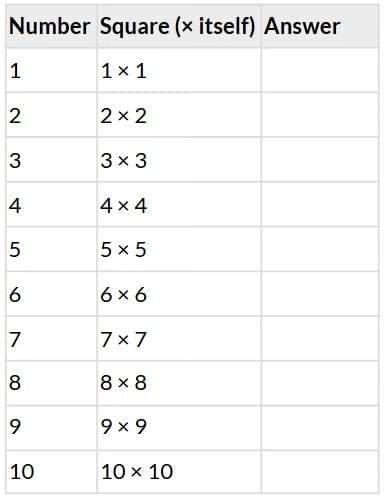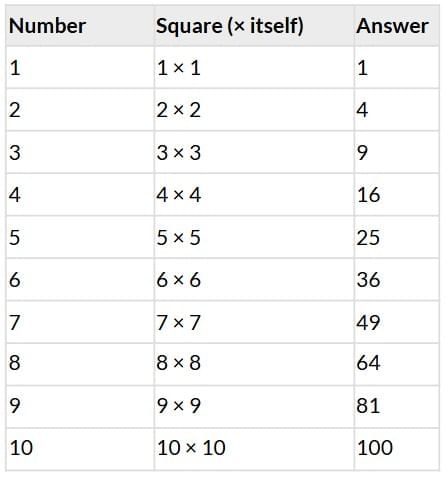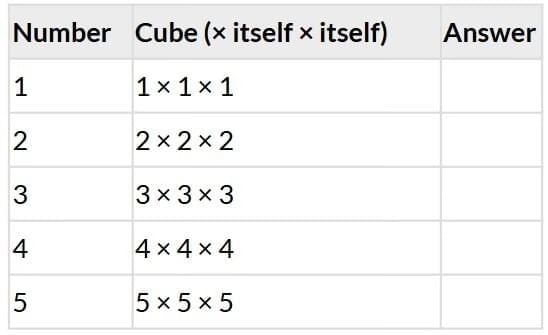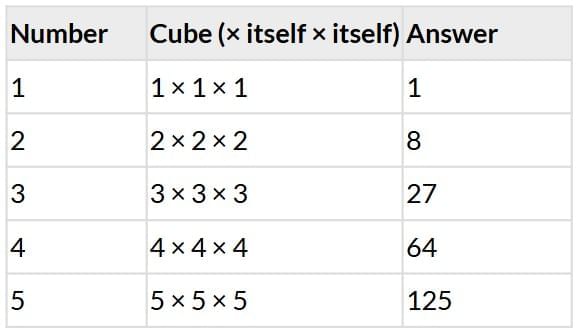Worksheet Solution: Square and Cube Root | Vedic Math for Junior Classes - English - Class 1 PDF Download
Section A: Understanding Square Numbers
A square number is the result of multiplying a number by itself.
Q: Complete the table below to find the squares of numbers from 1 to 10.

Section B: Find the Square Roots
Q: Write the square roots here:
- √64 = ______
- √100 = ______
- √49 = ______
- √36 = ______
- √25 = ______
Ans:
- √64 = 8
- √100 = 10
- √49 = 7
- √36 = 6
- √25 = 5
Section C: Understanding Cube Numbers
A cube number is the result of multiplying a number by itself three times.
Q: Fill in the table below to find the cubes of numbers from 1 to 5.


Section D: Find the Cube Roots
Write the cube root of each number:
- ∛27 = ______
- ∛8 = ______
- ∛64 = ______
- ∛125 = ______
- ∛1 = ______
Ans:
- ∛27 = 3
- ∛8 = 2
- ∛64 = 4
- ∛125 = 5
- ∛1 = 1
Section E: Vedic Math Trick – Squaring Numbers Ending in 5
Trick: To square a number ending in 5, multiply the first digit by the next digit and then write "25" at the end.
Example: 25 × 25 → 2 × 3 = 6 → Answer = 625
Now try:
- 15 × 15 = ___________
- 35 × 35 = ___________
- 45 × 45 = ___________
- 65 × 65 = ___________
Ans:
- 15 × 15 = 225
- 35 × 35 = 1225
- 45 × 45 = 2025
- 65 × 65 = 4225
Section F: Square Roots and Cube Roots (Finding the Number)
1. What number times itself is 25? (Square root of 25)
Ans: 5
Pair 25 as 25. Last digit is 5, so it’s 5 (5 × 5 = 25).
2. What number times itself 3 times is 8? (Cube root of 8)
Ans: 2
Try 2: 2 × 2 = 4, 4 × 2 = 8. It fits! So, it’s 2.
3. What number times itself is 64? (Square root of 64)
Ans: 8
Pair 64 as 64. Last digit is 4, so it could be 2 (2 × 2 = 4) or 8 (8 × 8 = 64). Since it’s 64, it’s 8.
4. What number times itself 3 times is 27? (Cube root of 27)
Ans: 3
Try 3: 3 × 3 = 9, 9 × 3 = 27. It fits! So, it’s 3.
5. You have 64 blocks in a cube shape. How many blocks on each side? (Cube root of 64)
Ans: 4
Try 4: 4 × 4 = 16, 16 × 4 = 64. It fits! So, each side has 4 blocks.
|
45 videos|41 docs|5 tests
|
FAQs on Worksheet Solution: Square and Cube Root - Vedic Math for Junior Classes - English - Class 1
| 1. What are the basic steps to square a number? |  |
| 2. How do you find the cube of a number? |  |
| 3. What is the difference between square roots and cube roots? |  |
| 4. How do you calculate the square root of a number? |  |
| 5. Can all numbers have real square roots and cube roots? |  |




















